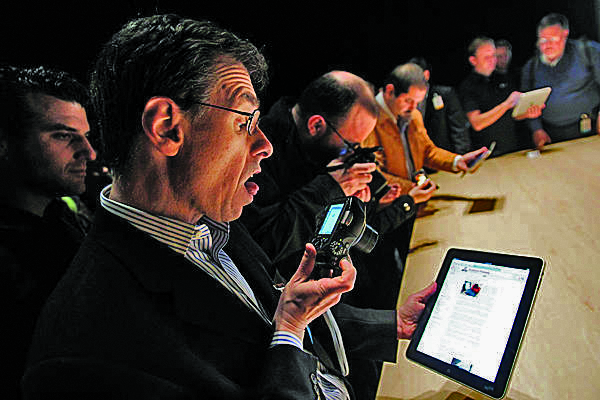By Simon Isham–
I’ll admit it: I’m addicted to my iPad. I use it to take notes. I use it to check my email at least fifty times per day. I use it to remind me to do my homework, and I use it to do homework. Without it, I would be late to every class, as my iPad keeps track of my schedule. So when Apple released their “new iPad,” it didn’t bother me. Both Apple and I realized that their latest device was not “new” enough to banish my iPad 2 into obsolescence. But there is a group who seems inclined to think that this year-old machine is now an outlandish relic.
That group is tech journalists, a tribe which regularly produces headlines such as “Why your smartphone is already a dinosaur” (CNN). On the other end of the timeline, they are responsible for much of the disappointing hype and futile speculation about rumored releases—often years before said releases actually occur.
One could say that this is due to tech journalists’ insulation from the market. Their salaries trend much higher than do those of other writers, with the notable exceptions being those of columnists and foreign correspondents. Tech writers often get extraordinary benefits packages compared to writers who cover other beats. They also tend to marry partners with higher salaries than they bring in, making their average household incomes $150K+. Not to mention that they are given the luxury of not having to foot the bill for the products they review. With all of these factors in mind, it is safe to say that writers of this breed are at risk of becoming out-of-touch with the spending habits of the masses.
Tech journalists might take a cue from haute couture, an industry which has drawn very similar criticisms of “fast-fashion”. As fashion industry giant Gabrielle “Coco” Chanel once famously stated, “Fashion fades, only style remains the same.” Similarly, there are some technologies, such as the original iPod, which cannot be easily replaced; 11 years of Apple’s innovation have been unable to dethrone the classic mp3 player from the company’s incessantly pruned product line. That’s because it is both elegant and durable, and therefore cost-effective. Unfortunately, there are very few devices that can make this claim, but they are out there. To find them, make a case for them and bring them to the attention of consumers is the charge of tech journalism.
Tech journalism, however, is not just about the technology itself. The people who make it happen are also important—or so we are to believe. The gadget facet of the journalism industry often uses publications as a place to name-drop. To prove this point, let’s try an experiment. Read these two lists of names below, and choose which list contains famous figures.
List A: Tim Cook, Steve Ballmer, Mark Zuckerberg, Larry Page.
List B: Virginia Rometty, Paul Otellini, John Chambers, Ji Seong Choi.
Unless you’ve been living in a media-restricted state, you chose list A. Both lists are comprised of the present CEOs of technology corporations, all of which are in the Forbes’ Top 100. The difference is that the CEOs of Apple, Microsoft, Facebook and Google are much better-known than those of IBM, Intel, Cisco and Samsung. Before the parvenus of Silicon Valley rose to fame, it used to be that the identities of executives were solely the domain of business journalists. But tech culture eventually matured out of its shy, nerdy phase and began to churn out celebrities as well. The members of list A are only half the story, though; real journalism seeks to cover all companies, to list all names, not just those that search engines are optimized to screen for.
It would be out-of-order for me to insinuate that all tech journalists are gossipy elitists or corporate slaves who live in a bubble free from financial concern. In fact, most are down-to-earth and without a trace of snobbery. Nevertheless, the problem of wanton nose-thumbing does exist.
For example, I am writing this opinion on a shiny new 27-inch quad-core iMac, and yet I find that I get greater speed on my duo-core Dell Precision T3400, a five-year-old machine which has suffered through two debilitating viruses. I have seen the Mac recommended on CNET as the best-available performance desktop by senior editor Rich Brown. The Dell machine, by contrast, has been discontinued. While the Mac’s tech spec sheet may portray the product as heaven-sent, my current computer is not yet démodé.
I wish I could expect more from those tech journalists who manage to command salaries for propounding the falsehood that ‘nothing less than cutting-edge suitable for use, but the fact is that people lap up that genre of drivel. Fact of life: writers will write what readers will read, useful or not, and publishers publish the stuff that sells.
[email protected]
Photo courtesy of csmonitor.com







